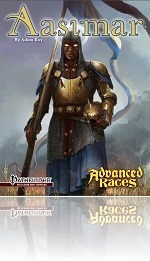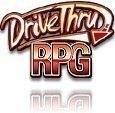 By Endzeitgeist
By Endzeitgeist
This installment of the advanced races-series clocks in at 20 pages, 1 page front cover, 1 page editorial/ToC, 1 page advertisement and 1 page SRD, leaving us with 16 pages of content, so let’s take a look, shall we?
We kick of this pdf, as always, with first a general look on the race of the aasimar as a setting-agnostic race before receiving excessive notes on how the work in the context of the Midgard campaign setting. Both do have something in favor for them – the first in that it treats aasimar less like humans with a tendency for goodness and more like nephilim – including more pronounced escalation, the latter for providing a spotlight on the different regions, including Shuppurak, where aasimar roam the streets – still one of the cooler concepts in Midgard in my book.
So after this fluffy introduction, we receive 6 new alternate racial traits for aasimar – these include exchanging one resistance for fire resistance 5, turning gaseous form for 3 rounds for every 5 character levels (with a missing italicization that extends to all traits of that style), blindsense 10 ft. or other spell-like abilities – searing light and 1/day dispel magic, to be precise. Now both gaseous form and dispel magic are somewhat iffy in my book – while not per se broken, do feature one unpleasant issue, namely that they provide very early counter-measures that usually are relegated to slightly higher levels. Nit-picky? Well, perhaps, but only for as long until you realize what you can do with gaseous form and that it can’t be counterspelled in this instance. There is also an Eagle’s Splendor version that deserves special mention – while also suffering from the flawed italicization, it does have a unique representation in a light-emitting, rather unsubtle halo upon activation – pretty cool imagery!
We also receive 6 new traits, 5 of them racial (though they do not note this) and one social – One is particularly…well, let’s not say overpowered, but rather circumstantially very strong: Blood Moon Born gives you a free Maximize Spell 1/night when under moonlight of a full moon. This would be what I’d call the “controlled lycanthrope conundrum” – lycanthropy is damn cool, but as soon as you can control it and there’s no risk, you’ll try to match the power-boost with your adventuring; This is something similar – while situational, it is very powerful. I think a less prohibited restriction and a less significant power boost would have made this a better trait. Child of the Living God is also too strong – +2 to intimidate, intimidate is always a class skill AND a +3 (wonky; usually +2 or +1)-bonus (untyped, as all of these bonuses – that should be trait bonuses) against creatures with divine, profane or channeling abilities. +3 to what? Atk? Saves? Intimidate? In the latter case, does it stack? No idea what this trait is supposed to do, needs a revision. (And no, didn’t mention all types of wonky wording in these…)
We also receive 4 mythic traits – here, the wording, alas, is not better – while one can *glean* what the author means by “All animals and magical beasts with an Intelligence of 1-3 are automatically moved one level of attitude in your favor”, this is NOT how starting attitude wording works. The Mythic Calm trait is also odd in that it allows the removal of the cowered condition as well as the frightened condition, but does nothing against panic or being shaken – the trait ignores negative condition hierarchy – an oversight? I don’t know. Mythic Mark falls completely off the rails in an almost tragicomical way – the trait allows you to generate a mark similar to a arcane mark, visible only to mythic creatures. This mark supposedly creates unease. The trait features this sentence: ”
All non-mythic enemies within 30 feet of your sigil are uneasy, whether they can perceive the mark or not, and their DCs on rolls to resist fear and Intimidate effects are increased by 2.”
Now I *know* what this ability *means* to do, but – read that carefully – as written, it would mean the creatures become more susceptible to fear AND harder to demoralize. This shows a basic ignorance of how demoralize works and makes it possible to completely invert the intention of the trait, creating confusion in spades. Urgh. Sensing mythic power is a cool idea as well, but one deviating significantly from how all comparable detection mechanics work – immediate awareness does not for a concise rules-aesthetic make here.
We also receive 4 new feats – and it’s a bit like a completely different author has written them – the overthrow-feat, for example, lets you use reach weapons to ground flying adversaries and does so with pretty concise mechanics – the mentioning of “stunning damage”, which does not exist, being the one issue in this one. I’d usually complain about the follow-up feat, which allows you to do that with thrown and projectile weapons, but the significant feat investment makes it somewhat work. There also are feats to increase your celestial resistances (BORING) that manage to not adhere to the same wording – while not wrong or problematic (and thus not subject to decreased rating), they are somewhat inconsistent – we once have an “increase by…” and once a “increase to” – yes, nitpicky, but that sort of thing does potentially create confusion.
We also receive no less than 8 mythic feats – granting DR is pretty solid, though one feat that specifically protects versus smite may be too circumstantial for many classes (unless the DM is even more smite happy than I am); Others….well, may overshoot their target goal; for example the very unfocused Angelic Scion: This feat (with moderate prereqs) grants you immunity to non-mythic poison and petrification, alter self at will, truespeech AND two slam attacks (no idea if primary or secondary, whether they follow the rules for natural weapons or not since they have a caveat “2 per round”…) and if you hit with both, the sucker on the receiving end has to save versus fort DC 25 or be stunned for 1d6 rounds. STUNNED. Yeah, I get the whole angel theme – still, that’s too much for a feat, has nigh no bearing on mythic tier/power, rules-wise, and is just all over the place. This needs to be broken down into multiple feats. Smite cleave, permanent amphibious template etc. may be strong and arguably, not very elegant, but can be defended. Beyond formatting issues, though, doubling your “first” (whatever *that* is supposed to mean…First attack? Smite’s damage bonus?) damage bonus (later triple and quadruple!) when smiting evil creatures. Ehem. I’m sorry, but has the author EVER seen what even a moderately competent smite can do? Even without an optimized build? If one class feature needed no upgrade to damage potential, it was friggin’ smite. +40, +60 and +80 to damage per attack via ONE feat. Not even gonna get near my mythic-adapted modules. Unfortunately, the other feats aren’t particularly inspired either, leaving me with not much nice to say.
Onwards to the archetypes, the first of which would be wis- instead of cha-using Celestial Rhymer. This bard casts divine spells and receives paladin spells as well and at later levels, they can spontaneously convert spells into healing spells, also receiving a domain at second level and even channel energy at 5th (though at least at level -4). Dirge of Doom is also modified – the archetype pays for that with versatile performance, well-versed and lore master. Yes. You heard right. I’m sorry, for I love the concept, but imagine me going full-blown Plinkett here and uttering “What were they thinking?” – so you remove any casting restrictions, add a bunch of spells from one of the strongest spell-lists (and take the spells, if they exist on multiple lists, on the lowest level), add channel and all the nasty tricks and spontaneous healing conversion as well as domains for THAT? Yes, the abilities taken away are neat…but they nowhere near justify this power gain. Plus: Wording issues. No, not gonna list ’em all. The Celestial Summoner also uses wis and once again, casts divine spells – seen that before in Will McCardell’s Celestial Commander, a powerful archetype one of my players uses, btw., so what does this one do? They may summon forth special celestials (with precise creature depending on HD) in a silent 1-minute prayer, with dismissal being possible as a standard action. These celestials adhere to pretty conservative healing rules and only one may be present at a given time – essentially, celestials as replacements for eidolons. While the ability is pretty complex, it gets rather close to working properly. It doesn’t fully reach that level, though. Celestial Summoners may only know, as mentioned x+wis-mod names of celestials to summon this way, with increased HD increasing the options available. So far, so nice – but do the numbers of true names known stack or do they simply increase by +1 when the celestial summoner increases in levels? Celestials are also vulnerable to “profane” spells and receive double damage from them. Issue here: There is no [profane] descriptor, not even profane damage, only profane bonuses. Unholy Blight, for example, deals untyped damage and channel energy deals negative energy damage. hence, this drawback needs complete rewiring. I haven’t even gone into some of the other issues here. At 18th level, 2 of these celestials can be in effect at a given time.
At higher levels, celestial summoners may sacrifice hit points to heal their summoned celestial allies and draw upon them to heal herself a limited amount of times per day. Here, a technicality is an issue – the wording implies that the hit points transferred heal the creature/summoner, when they should instead negate a likewise amount of damage. Why is this important? Because if damage kills the creature, it is sent back to its plane and can no longer benefit from the healing effect. A formality, yes, but an important one. The class also receives the benefits of partial apotheosis -which generally sounds like a solid choice – however, the “summoner’s racial energy resistances increase by +10” – what if the archetype doesn’t have any due to not being an aasimar? There is nothing preventing non-aasimar from taking this archetype, so what about these guys? This is relevant due to multiple abilities using this mechanic and wording type. As a capstone, the celestial summoner may conjure forth one of the most powerful good outsiders – solars, animal lords, star archons – pretty awesome. Conceptually, a cool archetype, but one that does have some significant streamlining to do.
The purifier inquisitor archetype receives a 3/day scorching ray and a second domain for solo tactics and teamwork feat. They also receive a divine-energy only flame strike are and may summon a very limited array of celestials as a standard action. A pretty disjointed and boring archetype in y book – nothing special or interesting here. We also get two new subdomains, the angel (deva) and radiance subdomains, both of which are pretty solid.
Next up would be 14 new spells, most of which with mythic alternate versions and augment options. These allow you to polymorph into angelic beings, conjure forth magnificent mansion-like fortresses, receive a celestial herald to carry your message (or objects!), receive a bardic atonement (nice, though the DC 25 DC perform check at the end is ridiculous – any bard capable of executing 6th level spells should NOT have to roll to succeed at that skill check!), forced conversions for inquisitors…per se nice. Where things turn baffling would be with Hammer of Righteousness –this is essentially a copy of holy smite, which instead of good, uses lawful as the type. Know what’s funny? Order’s Wrath already does exactly that. Instead of causing daze, this one causes FRIGGIN’ PARALYSIS – no duration!!! BAFFLING.
A) Paralysis is one of the most powerful conditions in PFRPG – it needs a duration. B) There already *is* a 4th level spell called order’s wrath that does just the same thing, but *with* a balanced condition. This spell is condition-escalation, more sloppy than its base variant and generally should not exist. Kill it with fire. Speaking of yet another blatant and unnecessary escalation of power with worse wording than its original: Imbue with Divine Power – not only spellsharing, now also available for palas, druids and rangers (there is a reason this was cle/orc-exclusive, you know…) and it allows you to share channel energy as well – same spell-level, btw. Oh, and channel energy can only be used to “turn or rebuke undead” – which does require a FEAT in PFRPG. Baffling in its ignorance of basic spell-balancing with a CORE (!!!) spell (same level, MOAR power) and pretty basic rules-concepts.
A better goodberry that allows for condition rerolls may not be inspired, but is solid when compared to the rest. A mythic variant of the mount-spell is nice in general concept, but wholly geared towards aasimar, which it shouldn’t be – mythic power or no mythic power, no vile wizard should be able to augment a such a spell to generate a half-celestial mount… Summons with an angel theme and a bardic spell that nets a +2 sacred bonus to perform checks may be okay, but also boring.
There also are new magic items, all of them mythic – from powerful shields to urns that can store mythic power, the items here are solid and nice even, especially when compared to the rest of the pdf. One significant word of warning, though: I’d *STRONGLY* advise any Dm to be very, very careful when allowing mythic power-storing urns in the game and closely monitor their availability – let your PCs craft these things and all comes crashing down at high levels. Not perfect, but far away from the issues of the majority of the crunch herein. Now on the very much damn cool side would be the final 4 transcendent artifacts – these legendary items can bestow mythic power on their non-mythic wielders and are all intelligent. As artifacts, I won’t hold their vast power and game-changer-level effects against them – after all, that’s their clear intent. Now on a nitpicky side, how the interaction between the granted mythic tiers and existing ones of potentially different paths is handled is never explained and the item-type could use some more concise definitions in how their abilities interact with fringe-cases, but at this point, I’m beyond complaining about such minor issues.
Conclusion:
Editing and formatting is okay – there are various italicization glitches and on a rules-language level, the pdf falls on its face pretty hard. Layout adheres to Kobold Press’ 2-column full color standard and the pdf does come fully bookmarked for your convenience. Artwork is a combination of re-used artwork, neat glyphs and the cover of KP’s awesome planar book.
What has happened here? I’ve read a bunch of pdfs by author Adam Roy and while he is not the most precise of authors out there regarding rules-language, I can’t really fathom what has happened here. The fluff and ideas herein are, as almost always in his writing, top-notch and inspiring and there are some true conceptual gems in here. I *do* enjoy the idea of making the larger-than-life nature of aasimar tied close to mythic rules and the focus on a more extreme aasimar-kind akin to myth’s nephilim is pretty awesome and I do like the concepts of the items…
…
Damn, I can’t find much more positive to say. The crunch herein is a total cluster-f***. Imprecise bonuses, wording issues, blatant power-escalation among spells, cloned spells sold as something new and archetypes and don’t get me started on the feats. If I didn’t know any better, I’d assume that this was the work of a total rookie. The fluff and often, the concepts herein – these are *awesome*, but balance is nowhere to be found herein and the crunch more often than not feels phoned in, like it cannot live up to the evocative concepts promised by the fluff…or like it did rule of cool everything. Don’t get me wrong – I’m all for breaking the rules if it does add something to the game, but what is added should better be up to snuff. This is not. It should be noted for everyone NOT using mythic rules, that all components that do not suffer from massive issues are mythic. The sudden focus on the mythic rules, while thematically fitting, feel a bit awkward and may result in unsatisfied customers who assumed they’d get more non-mythic oomph, so caveat emptor.
Were it not for the items and the glorious fluff, I’d bash this down to 1 star, comme un beau homme sans merci. It is explicitly and only due to the great fluff and damn awesome concepts and cool item-ideas, I will instead settle on a final verdict of 15 stars, BARELY rounded up to 2 stars.
Endzeitgeist out.
If you have enjoyed this RPG review, please consider becoming one of our Patreon sponsors.
Advanced Races 9: Aasimar is available from:
 |  |
Remember you can follow us on Twitter and Google+!
Thank you for your support.
